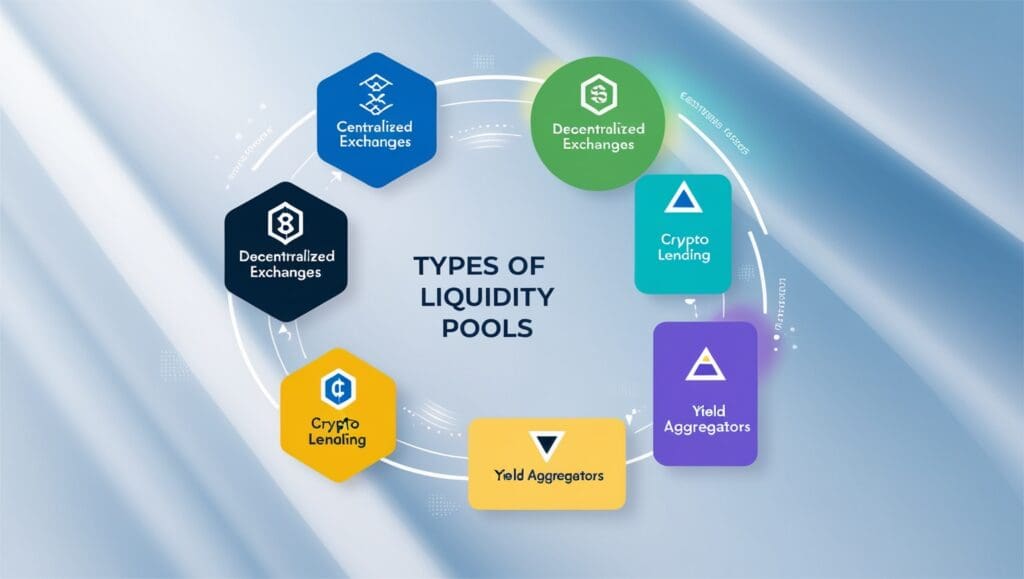In this article, I will explain a popular activity in the decentralized finance (DeFi) space which allows users to earn passive income by participating in liquidity pools.
Users can earn rewards by providing liquidity to decentralized exchanges in transaction fees and other incentives.
However, it is also pertinent to note the risks involved such as Impermanent loss and volatility.
I’ll take you through the steps of joining liquidity pools, the benefits of joining one, and the risks one must manage to ensure a good experience.
What Are Liquidity Pools?
Liquidity pools are made up of different coins or tokens which are locked in a smart contract and this collection is used for trading on decentralized exchanges like DEX.
These pools help users to trade in a currency without the need for an order book giving them liquidity for the transaction made.

For providing the pool, the liquidity providers are paid a portion of the trading fees. In most cases, the assets in the pool are paired and while maintaining the pool’s balance, the participants get rewards, for example ETH/USDT.
How To Participate In Liquidity Pools
Select a Platform
Make sure you have done your due diligence and also decide which DEX you want to use. Some of the more well-known options are Uniswap, SushiSwap, and PancakeSwap.
Connect Your Wallet
Now you would need a crypto wallet that is compatible like MetaMask, Trust wallet, etc and connect that with your selected DEX.
Select a Pool
Here you would need to provide assets with matching liquidity pools that you select. A majority of pools are based on two Tokens for e.g ETH/USDT , BTC/USDC
Add Liquidity
Press the add liquidity button and write down the amount of each Token you would like to provide to the pool, now confirm the transaction and pay the translation fees.
Earn Rewards
As soon as you add your liquidity into the pool, you will begin to earn rewards both in terms of transaction fees as well as possibly further incentives set forth by the platform.
Monitor Your Investments
Always keep an eye on your assets and the pool you have invested into, and be ready to alter your strategies based on the market changes.
Types of liquidity Pools

Token Pair Pools: These are the kind of pools that have two tokens combined such as ETH/USDT. Such pools are contributed to by liquidity providers who provide equal amounts in terms of value for the single tokens.
Stablecoin Pools: These pools hold a USDC/USDT stablecoin which tends to be more stable making it a safer option for liquidity providers.
Single-Asset Pools: Only one asset needs to be provided which allows users to give liquidity for just the ETH for example on the ETH platform.
Multi-Asset Pools: These types of assets if put together in a pool ensure that the token has a high amount of flexibility although managing the risks becomes more complex.
Tools and Platforms For Liquidity Pools
Uniswap: A very popular decentralized exchange, which is also a DEX, is UniSwap permitting users to add liquidity in pairs of tokens on the ETH network. The platform operates using Automated Evolutionary Markers while also having a straightforward user interface to facilitate ordering in pools.
SushiSwap: A DEX that is governed by the community like that of Uniswap, SushiSwap contains liquidity along with sushi swap which channels more features such as staking and yield farming.
PancakeSwap: It is also a DEX but owns the Binance Smart Chain allowing lower fees on transactions with an assortment of liquidity pools for their token pairs.
Curve Finance: Curve is extensively tolerable offered liquidity provider by concentrating on stablecoin liquidity pools, it enhances efficient trading of the movement of stable coin assets which in turn decreases slippage.
Balancer: A DeFi platform with an all-encompassing scope, Balancer has multi-asset liquidity pool support, which allows users to mint their own liquidity pools that are up to eight tokens with the custom proportion to amounts of the liquidity and receiving fees based on that.
1inch: A Combination Decentralized Exchange where users can combine multiple platforms at one attempting to get the best rate, 1inch also facilitates liquidity along with yield farming.
DeFi Pulse: This is a powerful and widely used analytic tool on all DeFi platforms, it provides users with analytics such as pool statistics to help them strategize.
Benefits Liquidity Pools
Generating Passive Income: Providers get to earn some percentage of transaction fees from trades made in the pool which serves as an opportunity for steady passive income because of their contribution in setting up liquidity pools.
Ability to Participate in Yield Farming: Liquidity Contributors also have the opportunity to engage in Yield Farming, which allows them to earn extra incentives such as governance tokens or interest through locking their assets into specific available pools.
Enhanced Liquidity in the Market: These liquidity pools help facilitate seamless and quicker transactions on DEXs, allowing users to exchange their assets with minimal price range movements or slippage.
Getting Involved with Decentralized Finance: Users are unwilling to remain passive and are ready to interact with the DeFi networks via liquidity pools, aiding in the further decentralizing of the finance realm and providing access to new financial products and services without depending on a financial intermediary.
Pros And Cons
Pros:
Ability to Generate Passive Income: As a liquidity provider, passive income is generated as one earns a portion of transaction fees earned in addition to some special payments that may be made.
Investment Portfolio Diversification: With the adventurous nature of taking part in liquidity pools, these are a great way to spread investments across a number of tokens and assets mitigating risk.
Simple Participation in Decentralized Finance: As mentioned above, by providing liquidity, users get a chance to directly interact with DeFi apps, which is progressive compared to conventional finance.
Traders Enjoy Low Slippage: Through the provision of liquidity to liquidity pools, users help in improving the overall liquidity of the market, making transactions to be faster and smoother.
Cons:
Occurrence of Impermanent Loss: When the prices of the paired assets in the liquidity pool determine the value of the assets and one liquidity provider’s token price changes drastically, there is an impermanent loss which refers to the situation where am asset will lose value as compared to holding the asset outside the liquidity pool.
Smart Contract Liabilities: Smart contracts are a prerequisite in practicing liquidity pools and there is room for bugs or attacks to occur, which can possibly cause a loss of funds.
Fluctuating Market Conditions: During times of volatility, the market can be unpredictable and the value of the assets being kept in liquidity pools can vary significantly leading to losses for the liquidity suppliers.
Beginner’s Dilemma: Users of liquidity pools often have to grapple with concepts such as smart contracts, yield farming, and impermanent loss, however, these seem difficult to understand to new users.
Conclusion
To sum up, adding funds to liquidity pools can prove to be useful if one wants to earn passive income while also participating in the DFI platforms, however such a technique carries a whole gamut of risks such as impermanent loss and change in the market.
This means, it is important to analyze the architecture of the pool, the possible risk-reward ratios and focus on those platforms which seem secure enough.
There are best practices, which if obeyed, would help liquidity providers minimize risks and maximize profitability, therefore accelerating the development of the decentralized economy.









